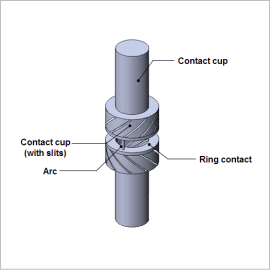*Please prepare a license ID and password for the license administrator.
*It is different from the service for JMAG WEB MEMBER (free membership). Please be careful.
Overview

Vacuum circuit breakers have the function of breaking the current when a large current flows due to a short circuit or other reason in distribution boards, etc. When the vacuum circuit breaker breaks the current, metal vapor is discharged from the contacts and becomes a plasma, producing an arc. Vacuum evaporation may occur due to this arc.
To avoid vacuum evaporation caused by an arc, a magnetic field is created by the arrangement of the contacts, and the arc is diffused with Lorentz force. Because the construction of the contacts is complex, it is important to analyze the magnetic field using the finite element method (FEM), which can handle complex geometries, to estimate whether the arc will be adequately diffused.
This Application Note presents how to calculate the current density and Lorentz force of a vacuum circuit breaker, and obtain its arc-diffusing force.
To avoid vacuum evaporation caused by an arc, a magnetic field is created by the arrangement of the contacts, and the arc is diffused with Lorentz force. Because the construction of the contacts is complex, it is important to analyze the magnetic field using the finite element method (FEM), which can handle complex geometries, to estimate whether the arc will be adequately diffused.
This Application Note presents how to calculate the current density and Lorentz force of a vacuum circuit breaker, and obtain its arc-diffusing force.
Lorentz Force

The direction of the Lorentz force generated in the arc is shown in fig. 1. A force of 6 N works in a direction -51 deg from an X-axis passing through the center of the arc.
Current Density Distribution and Magnetic Flux Density Distribution
The current density distribution is shown as a vector plot in fig. 2, and the magnetic flux density distribution of a cross-section of the arc is shown as a contour plot in fig. 3. Current flowing in the contact cup as shown in fig. 2 causes magnetic flux to be generated as shown in fig. 3. The magnetic flux density to the upper left of the center of the arc is larger than the magnetic flux density to the lower right. Therefore, force is produced from the upper left to the lower right.




